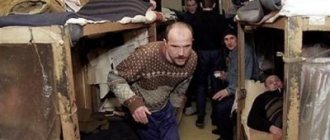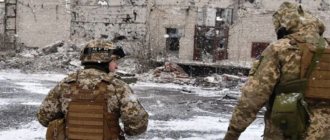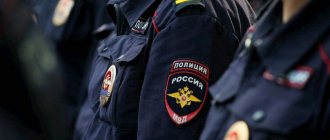Over the past ten years, terrorists have become much more active in hostage-taking practices. With the help of innocent victims, they strive to achieve their goal, be it money, the release of accomplices from arrest, or religious reasons.
We will not understand what goals the criminals pursue when taking hostages. Our goal is to introduce you to an effective model of behavior that will help save life in such a situation. From today's article you will learn what to do and how to behave correctly if you find yourself hostage by terrorists.
Assessing the terrorist's physical and emotional state
Depending on the situation, the extent to which the behavior and personality of the offender is assessed may vary. If the hostage has the opportunity to take a close look at the person’s behavior, then it is worth assessing in detail his emotional state and physical parameters. However, often in a hostage situation, there is a threat of violence in which it is important to determine the extent of the threat.
The degree of threat must be determined taking into account the personality classification:
- Mentally normal person without behavioral peculiarities.
- A mentally normal person in a state of alcoholic or drug intoxication.
- A person with obvious mental deviations expressed in behavior.
When assessing the condition of a criminal who has taken hostages, you need to understand whether there is a risk of attack on his part at the moment. If such a threat exists, the first step is to assess the physical characteristics of the potential attacker.
RULES AND PROCEDURES FOR CONDUCT OF THE POPULATION IN THE EVENT OF THE THREAT AND IMPLEMENTATION OF A TERRORIST ACT
1. In case of terrorist acts:
Every citizen, finding himself in an emergency area, is obliged to exercise self-control, influence others by personal example, and, if necessary, stop cases of robbery, looting and other violations of the law.
Having provided first aid to family members, others and himself, a citizen must take part in eliminating the consequences of a natural disaster, using personal transport, tools, medicines, dressings, etc. Terrorists can install explosive devices in the most unexpected places, basements, rented premises, rented apartments, parked cars, etc. Currently, both industrial and improvised explosive devices can be used. Explosive devices can be disguised as any household items, including boxes of office equipment, milk bags, video cassettes and even children's toys, etc. Most often, such explosive devices are configured to instantly explode when any attempt is made to move them . Therefore, under no circumstances should you pick up this kind of ownerless items, be sure to instruct your children about this, and if you find any, immediately report them to the police. Remember: correct and competent actions will help save your life and the lives of your loved ones. If an explosion threat finds you indoors, beware of falling plaster, fittings, cabinets, and shelves. Stay away from windows, mirrors, and lamps. While on the street, run to the middle of it, to a square, a vacant lot - away from buildings, structures, poles and power lines. If you are notified in advance of the threat, before leaving your home or workplace, turn off the gas and electricity. Take the necessary things and documents, a supply of food and medicine. 2. Security measures in the event of a threat of terrorist attacks:
Be extremely attentive to suspicious objects around you. Do not touch or handle them. Report these items to the competent authorities: telephone numbers. In any situation, do not panic, do not lose your presence of mind. Inform your neighbors and relatives about the information received, and if necessary, provide assistance to the victims. If possible, go with your children and elderly relatives for a few days to the dacha, to the village, to visit relatives outside the city. Secure your home: remove fire hazardous items - old supplies of paints, varnishes, gasoline, etc.; remove flower pots from the windows (place them on the floor); cover the glass windows with strips of paper, if possible, cover the windows with shields; turn off the gas, extinguish the fire in stoves and fireplaces; prepare emergency lighting sources (lanterns, etc.); create a supply of medicines and a 2-3 day supply of drinking water and food; draw the curtains on the windows - this will protect you from damage from glass fragments. Place the necessary documents, things, and money in your bag in case of emergency evacuation. Use public transport as little as possible. Postpone visiting public places. Provide psychological support to old people, the sick, and children.
3. If an explosive object is detected:
The danger of an explosion can be judged by the following signs: the presence of an unknown package or any part in the car, on the stairs, in the apartment, etc.; stretched wire, cord; wires or insulating tape hanging from under the car; someone else's bag, briefcase, box, any object found in a car, at the door of an apartment, in the subway. If you notice an explosive object (improvised explosive device, grenade, shell, bomb, etc.), do not come close to it, call the people nearby and ask them to immediately report the find to the police. Do not allow random people to touch a dangerous object or try to neutralize (check) it. When entering the entrance, pay attention to strangers and unfamiliar objects. As a rule, explosive devices are placed in a building in basements, on the first floors near load-bearing walls, under stairs near elevators and garbage chutes. Be vigilant.
4. Actions of people when committing terrorist acts
If suddenly there was an explosion, but you were not covered with fragments of walls, furniture, or ceilings. In this case, there may be mild to moderate injuries from household objects. Don't get lost. Calmly clarify the situation. In case of necessary evacuation, take documents, portable essentials, money (passbooks). Move carefully, do not touch sagging structures, or touch exposed wires. Do not use an open flame to avoid an explosion of the gas-air mixture. In case of heavy smoke or dust, use cotton-gauze bandages or protect your respiratory organs with a moistened piece of cloth (handkerchief, towel, piece of sheet, tablecloth, etc.). Act in strict accordance with the instructions of the warning system (mutual information) officials. If you are overwhelmed by the rubble of walls, try not to lose heart, do not despair, calm yourself down if possible, breathe deeply and evenly, prepare yourself to endure hunger and thirst, do not waste strength by moving slightly. Use your voice and knock to attract people's attention, especially if you hear their actions nearby. If you are deep from the surface of the earth, move any object (ring, keys, bracelet, etc.) right or left to detect you with a metal detector. Save oxygen, do not light matches, candles, or lighters. Move (move) carefully so as not to cause a new collapse; be guided by the movement of air coming from outside. If possible, use improvised means (objects) - board, brick, etc. strengthen the load-bearing slab (ceiling) from collapse. Calmly wait for help. If you are very thirsty, put a small pebble in your mouth and suck on it, breathing through your nose.
RECOMMENDATIONS ON RULES OF SAFE BEHAVIOR IN THE THREAT OF A TERRORIST ACT
Explosions on the street, in the yard, in the house and in the car have become part of our everyday life. Terrorists are very creative and have a wide arsenal of explosive devices, ranging from homemade devices to grenades and mines used by the military.
Timely detection of explosive objects will save the lives of you and other people. In order to avoid becoming a victim of an explosion, you need to know a number of signs of explosive devices. An explosive device can be hidden in a beer can, a pack of cigarettes, a toy, a bottle, or in a piece of pipe, a milk carton, or any package or box.
The fact that an explosion may occur can be judged by a number of signs:
• an unknown thing ended up in a car, in the entrance of a house, in the yard, etc.;
• remains of various materials atypical for the site;
• stretched wire, cord;
• an unfamiliar smell where there has never been one, for example, soup seasoning (this is what some types of explosives smell like);
• areas of freshly dug earth or dried earth that were not there before;
• someone else's bag, briefcase, box or other ownerless item that happens to be nearby your home or apartment.
If you find ownerless or suspicious items:
• do not touch unowned items. Under no circumstances should you attempt to defuse an explosive device yourself;
• If you notice a suspicious thing, immediately contact a police officer. Do not touch the find and do not let other people near it.
Rules of conduct if an explosion occurs
If the explosion occurred and you survived:
• try to calm down and clarify the situation, leave the room;
• move carefully, do not touch damaged structures and wires with your hands;
• in a destroyed or damaged room, due to the danger of an explosion of accumulated gases, do not use open flames (matches, lighters, torches, etc.)
• if the room is smoky, protect your respiratory organs with a moistened scarf, piece of cloth, or towel;
• turn on the apartment warning system (TV, radio), check the possibility of mutual communication, and report the incident to law enforcement agencies by phone;
• In case of forced evacuation, help parents take the necessary things, all doors and windows in the apartment must be closed, notify neighbors about the evacuation;
• If it is impossible to evacuate, you must take measures to make them aware of you; to do this, you can go out onto the balcony or open the window and call for help;
• After leaving the house, move away from it to a safe place; in the future, for this purpose, act strictly in accordance with the instructions of officials.
Rules of conduct in cases of being taken hostage or kidnapped
Taking people hostage and kidnapping people for ransom is one of the common types of terrorism.
Anyone can be taken hostage. Recently, hostage-taking and kidnapping cases have become more frequent around the world. These criminal offenses, as a rule, are accompanied by insults to the honor and dignity of captured citizens, oppression of moral and physical suffering, and bodily harm.
To reduce the risk factors of being taken hostage, as well as reducing the risk of serious consequences, it is necessary to know and follow a number of rules developed by specialists from the experience of negotiating with terrorists and when releasing hostages.
Rules of conduct in cases of hostage taking
• do not expose yourself to unnecessary risks, try to limit contacts with criminals, do not cause aggression in them with your actions or words, especially if they are under the influence of alcohol or drugs;
• try to mitigate the hostility of criminals as much as possible by remaining flexible, calm and peaceful.
• do not resort to extreme measures in order to free yourself if, immediately during capture, you managed to escape and escape;
• from the moment of capture, control your actions. Try to record all the actions of criminals.
• assess your location and do not panic, try to remain calm, even if criminals threaten you with physical harm, and also try to limit your mobility, vision or hearing, create difficult living conditions, for example, restrict food and water;
• use every opportunity to convey information about your location, signs of criminals, and the characteristics of their behavior to your relatives or law enforcement agencies;
• do not react to the provocative actions of terrorists, do not ask them questions and try not to look them in the eyes: this may cause additional aggression towards you. Follow the terrorists' demands and ask them for permission for any of your actions.
• in a vehicle seized by a terrorist, stay in your place, do not move around the cabin, try to attract the attention of criminals as little as possible;
• avoid rash actions that could endanger your life and the lives of other passengers, especially when aircraft are hijacked by terrorists.
• In the event of a forceful release of hostages (during an assault by a special unit), try to hide behind objects (a chair, table and other pieces of furniture), cover your body from bullets with improvised means, with everything that can weaken the penetrating effect of bullets.
• Try to move away from the entrance doors, windows, portholes, hatches and take a horizontal position, remaining in it until the commander of the assault group receives a command to exit the room. In the future, unquestioningly follow all his commands.
• During the assault, do not pick up the weapons of criminals, as you may be mistaken for bandits and open fire to kill.
• Try, if possible, not to let the bandits take your place among the hostages.
The success of your liberation depends on your endurance and ability to navigate a difficult environment.
Rules of conduct if you are attacked for the purpose of kidnapping
Try to make as much noise as possible to attract the attention of others and fight off attackers.
To reduce the risk of kidnapping, the following precautions should be taken:
• It is necessary to know well the area where you live, its most deserted areas;
• If you feel like someone is following you, turn around and check your suspicions. If this suspicion is confirmed, change the direction, pace of walking or flee;
• Do not get into a car with strangers or unfamiliar people;
• You should categorically refuse, especially girls, from evening walks through vacant lots and construction sites;
• Never open the apartment door unless you know who is calling, especially if you are home alone.
Ensuring personal safety during a shootout
A person can find himself under a hail of bullets for a variety of reasons: criminal, political, military. Recently, this situation has become quite common. How should a civilian behave in this situation?
Rules of conduct during a shootout
• Do not stay indoors near windows. This is dangerous not only because of the threat of ricochet. Experience shows that a bullet, having flown into a room, can ricochet off the walls and ceiling more than once, especially in concrete houses.
• You must immediately move away from the windows. If there is a bathroom, then it is advisable to hide there, lie on the floor or in the bathtub.
• While in your shelter, you need to watch for the appearance of smoke and fire. Every 3-5th bullet is a tracer, so the risk of fire is high.
• If a fire starts and the shooting does not stop, you must crawl out of the burning room (apartment), closing the doors behind you. In the entrance, it is best to hide away from the windows, for example in a niche.
• It is dangerous to approach windows and go out onto the balcony even if they are shooting far from your home.
• When outdoors, you need to find shelter. They can be a building ledge, stone steps, a monument, a fountain, a concrete pillar, a brick fence or a curb. You need to crawl to the shelter. It's dangerous to run: you might be mistaken for an enemy.
• If you are hiding behind a car, keep in mind that its metal is thin and there is fuel in the tank, but in any case, even such shelter is better than no shelter at all.
• In such cases there is no clear advice; the decision must be made on the spot.
• Of course, there are also unconditional things: do not allow onlookers to stand and watch the shootout; first of all, children, elderly people and women should be saved.
On the procedure for receiving messages containing terrorist threats by telephone
Remember that the following actions will greatly help law enforcement agencies in preventing crimes and searching for criminals:
Try to remember the conversation verbatim and record it on paper;
As the conversation progresses, note the gender, age of the caller and the features of his (her) speech:
• Voice - loud or quiet, low or high;
• Rate of speech - fast or slow;
• Pronunciation - clear, distorted, stuttering, lisping, with an accent or dialect;
• Manner of speech - cheeky, mocking, with obscene expressions. Be sure to note the sound background (the noise of cars or railway transport, the sounds of television or radio equipment, voices, etc.), as well as the nature of the call (city or intercity).
Be sure to record the exact time the conversation started and its duration.
In any case, try to get answers to the following questions during the conversation:
• Where, to whom, what phone number is this person calling?
• What specific demands does he/she make?
• Does he/she make the demands personally, act as an intermediary, or represent some group of people?
• Under what conditions does he (she) or they agree to give up the plan?
• How and when can he/she be contacted?
• Who can or should you tell about this call? Try to get the caller to give the caller as much time as possible for you and your parents to make a decision or take some action.
If possible, inform your parents about it during the conversation; if not, immediately after it ends.
Do not talk about the fact of the conversation and its content. Limit the number of people who have the information received as much as possible.
If you have an automatic number identifier (ANI), write down the identified phone number in a notebook, which will avoid its accidental loss.
When using sound recording equipment, immediately remove the cassette (mini-disc) containing the recording of the conversation and take measures to ensure its safety. Be sure to install another one in its place.
General rules for providing first aid in emergency conditions
First medical aid is the simplest urgent measures necessary to save the life and health of victims. She must be on the scene before the doctor arrives or the victim is taken to the hospital.
It should be remembered that the further health of the victim and even his life depend on the timeliness and quality of first aid. For some minor injuries, medical assistance to the victim may be limited only to the scope of first aid. However, for more serious injuries (fractures, dislocations, bleeding, damage to internal organs, etc.), first medical aid is the initial stage of treatment, since after it has been provided, the victim must be taken to a medical facility. First aid is very important, but it will never replace qualified (specialized) medical care. You should not try to treat the victim yourself, but after providing first aid, you should immediately consult a doctor.
Rules for providing first aid in emergency conditions
Basic rules for providing first aid in emergency conditions.
First aid
is a type of medical care that includes a set of simple medical measures aimed at temporarily eliminating causes that threaten the life of the affected person. First medical aid is performed at the scene of injury by the victim himself (self-help) or by other citizens (mutual aid) who happen to be nearby.
The main goal of first aid is to save the life of the victim and quickly evacuate him from the affected area. The optimal time for providing first aid is 10-15 minutes after receiving a lesion. The effectiveness of first aid depends on the level of medical training of those providing assistance, as well as on the time factor. Thus, among victims who received first aid within 30 minutes after the injury, complications occur half as often as among victims who received first aid later than the specified period.
The absence of first medical aid within 1 hour after the injury increases the number of deaths among those affected who had a chance to survive by 30%, up to 3 hours - by 60%, and up to 6 hours - by 90%. The ability to provide first aid in emergency situations should be mastered by all categories of the population, including students.
Timely provision of first aid even by a non-medical worker (citizens who have undergone certain training in the rules of first aid) can reduce the mortality rate among those affected by half.
Rules for providing first aid for injuries (damage) (bruises, dislocations, sprains)
Bruises
Bruises can damage superficial tissues and internal organs .
Signs: pain, swelling, bruising. First aid - applying a pressure bandage, applying cold, creating rest. Severe bruises of the chest or abdomen may be accompanied by damage to internal organs: lungs, liver, spleen, kidneys, pain and often internal bleeding. Cold is applied to the site of the injury and the victim is urgently taken to a medical facility. With head injuries, brain damage may occur: contusion or concussion. Signs: headaches, nausea, sometimes vomiting, consciousness is preserved. A concussion is accompanied by loss of consciousness, nausea and vomiting, severe headaches, and dizziness. First aid is to provide complete rest to the affected person and apply ice to the head.
Dislocations
Dislocations
- this is a displacement of the articular ends of bones, partially or completely disrupting their mutual contact.
Signs: the appearance of intense pain in the affected joint; dysfunction of the limb, manifested in the inability to perform active movements; forced position of the limb and deformation of the joint shape. Traumatic joint dislocations require immediate first aid. Timely reduction of a dislocation with proper subsequent treatment leads to complete restoration of the impaired limb function.
First medical aid - fixation of the injured limb, administration of an anesthetic and referral of the victim to a medical facility. Fixation of the limb is carried out with a bandage or hanging it on a scarf.
In case of dislocation of the joints of the lower limb, the victim is taken to a medical facility in a supine position (on a stretcher, with pillows or soft objects placed under the limb (folded blanket, jacket, sweater, etc.) and its obligatory fixation.
When providing first aid in unclear cases, when it is not possible to distinguish a dislocation from a fracture, the victim is treated as if he had an obvious broken bone.
Sprains
Sprains
- damage to soft tissues (ligaments, muscles, tendons, nerves) under the influence of a force that does not violate their integrity.
Most often, sprains of the ligamentous apparatus of the joints occur due to incorrect, sudden and sharp movements. In more severe cases, a tear or complete rupture of the ligaments and joint capsule may occur. Signs: the appearance of sudden severe pain, swelling, impaired movement in the joints, hemorrhage into the soft tissues. When you feel the stretch site, pain appears.
First medical aid is to provide rest to the victim, tightly bandage the damaged joint, ensuring its mobility and reducing hemorrhage. Then you need to consult a traumatologist.
Rules for first aid for wounds and bleeding
Wounds
Wound
- mechanical damage to the body, often accompanied by a violation of the integrity of muscles, nerves, large vessels, bones, internal organs, cavities and joints.
Depending on the nature of the damage and the type of wounding object, wounds are cut, chopped, chopped, bruised, crushed, gunshot, lacerated and bitten. Wounds can be superficial or deep, which, in turn, can be non-penetrating and penetrating into the cavity of the skull, chest, and abdominal cavity. Penetrating injuries are especially dangerous.
Incised wounds usually gape, have smooth edges and bleed profusely. With such a wound, the surrounding tissues are slightly damaged. Puncture wounds are the result of penetration of piercing objects into the body. Puncture wounds are often penetrating. The shape of the entrance hole and the wounded channel depends on the type of wounding weapon and the depth of its penetration. Puncture wounds are characterized by a deep canal and often significant damage to internal organs. This often results in internal bleeding in the body cavity and the development of infections.
Chopped wounds are characterized by deep tissue damage, wide gaping, bruising and concussion of surrounding tissues; bruised and lacerated wounds - a large number of crushed, bruised, blood-soaked tissues.
Gunshot wounds arise as a result of a bullet or shrapnel wound and can be through, when they have an entrance and exit wound opening, blind, when a bullet or shrapnel gets stuck in the tissue, and tangential, in which a bullet or shrapnel, flying tangentially, damages the skin and soft tissues without getting stuck in them.
First aid is to first detect the wound; in this case, depending on the nature of the wound, weather and local conditions, outer clothing is removed or cut. First, remove clothes from the healthy side, and then from the affected side. In the cold season, in order to avoid chilling, as well as in emergency situations, when providing first aid to a victim in serious condition, clothing is cut in the area of the wound. Do not remove stuck clothing from the wound; it must be carefully cut with scissors. A bandage is applied to any wound, aseptic if possible. In most cases, the means of applying an aseptic dressing is a medical dressing bag, and in its absence - a sterile bandage, cotton wool, or, in extreme cases, a clean cloth. If the wound is accompanied by significant bleeding, it is stopped by any suitable method. In case of extensive soft tissue injuries, bone fractures and injuries to large blood vessels and nerve trunks, immobilization of the limb with a special or improvised means is necessary. The victim is administered a painkiller, given antibiotics, and quickly transported to a medical facility.
Bleeding
Bleeding
- effusion of blood from damaged blood vessels.
It is one of the private and dangerous consequences of wounds, injuries and burns. Depending on the type of damaged vessel, arterial, venous and capillary bleeding are distinguished. Arterial bleeding occurs when the arteries are damaged and is the most dangerous. Signs: scarlet blood flows from the wound in a strong, pulsating stream. First aid is to lift the bleeding area, apply a pressure bandage, bend the limbs at the joint as much as possible and squeeze the vessels passing through this area with your fingers and a tourniquet.
The vessel should be pressed above the wound, at certain anatomical points, where muscle mass is less pronounced; the vessel passes superficially and can be pressed from the underlying bone. It is better to squeeze with several fingers of one or both hands. A reliable way to temporarily stop arterial bleeding in the upper and lower extremities is to apply a hemostatic tourniquet or twist, i.e., circular tug on the limb. In the absence of a tourniquet, use any available material (rubber tube, trouser belt, scarf, rope, etc.).
The procedure for applying a hemostatic tourniquet
1. A tourniquet is applied when large arteries of the extremities are damaged above the wound so that it completely compresses the artery.
2. Apply a tourniquet with the limb elevated, placing soft tissue (bandage, clothing, etc.) under it, and make several turns until the bleeding stops completely. The coils should lie close to one another so that folds of clothing do not fall between them. The end of the tourniquet is securely fixed (tied or fastened with a chain and hook). A properly applied tourniquet should stop the bleeding and the disappearance of the peripheral pulse.
3. Be sure to attach a note to the tourniquet indicating the time of application of the tourniquet.
4. The tourniquet is applied for no more than 1.4-2 hours, in the cold season - for 1 hour.
5. If it is necessary to keep the tourniquet on the limb for a longer period of time, loosen it for 5-10 minutes (until the blood supply to the limb is restored), while pressing the damaged vessel with your fingers. This can be repeated several times, each time reducing the time between manipulations by 1.5-2 times compared to the previous one. The victim is immediately sent to a medical facility to completely stop the bleeding.
Venous bleeding occurs when the walls of the veins are damaged. Signs: dark blood flows from the wound in a slow, continuous stream. First aid is to elevate the limb, bend it at the joint as much as possible, or apply a pressure bandage. In case of severe venous bleeding, they resort to pressing the vessel. The damaged vessel is pressed against the bone below the wound. This method is convenient because it can be performed immediately and does not require any equipment.
Capillary bleeding is a consequence of damage to the smallest blood vessels (capillaries). Signs: the wound surface is bleeding. First aid is applying a pressure bandage. A bandage (gauze) is applied to the bleeding area; you can use a clean handkerchief or white cloth.
Rules for providing first aid for burns and poisoning
Burns
Chemical burn
Chemical burn
- the result of exposure to tissues (skin, mucous membranes) of substances with a pronounced cauterizing property (strong acids, alkalis, salts of heavy metals, phosphorus).
Most chemical burns of the skin are industrial, and chemical burns of the mucous membrane of the oral cavity, esophagus, and stomach are more often domestic.
Exposure to strong acids and salts of heavy metals leads to dehydration of the burn site and the formation of a dense gray crust of dead tissue, which prevents the action of acids on deeper tissues. Alkalies cause tissue necrosis, which takes on the appearance of a white soft scab. Determining the degree of a chemical burn in the first days is difficult due to insufficient chemical manifestations.
First aid is to immediately wash the affected surface with a stream of water, which completely removes the acid or alkali and stops their damaging effect; neutralization of the acid residue with a 2% solution of sodium bicarbonate (baking soda); neutralization of alkali residues with a 2% solution of acetic or citric acid; applying a sterile bandage to the affected surface; giving the victim painkillers.
Phosphorus burns are usually deep because phosphorus continues to burn when it comes into contact with the skin.
First aid is to immediately immerse the burned surface in water or sprinkle it with plenty of water; cleaning the burn surface from pieces of phosphorus: applying a lotion with a 5% solution of copper sulfate to the burn surface; applying an aseptic (sterile) dressing; giving the victim painkillers.
The application of ointment dressings, which can enhance the fixation and absorption of phosphorus, is excluded.
Thermal burn
Thermal burn
- a type of injury that occurs when body tissue is exposed to high temperature. A burn can be caused by exposure to light radiation, flame, boiling water, steam, hot air, or electric current (the nature of the agent that causes the burn).
Burns can be of various locations (face, hands, torso, limbs) and occupy different areas.
Based on the depth of damage, burns are divided into four degrees:
1st degree - hyperemia and swelling of the skin, accompanied by burning pain;
2nd degree - the formation of bubbles filled with a transparent yellow liquid;
3. a) degree - spread of necrosis to the epidermis;
3. b) degree - necrosis of all layers of skin;
4th degree - necrosis of not only the skin, but also the underlying tissues.
First aid is to immediately stop the action of the traumatic agent. To do this, you need to throw off the burning clothes, knock down the person running in burning clothes, pour water on him, cover him with snow, cover the burning area of clothing with a coat, blanket, tarpaulin, etc.; extinguishing a burning incendiary mixture. When extinguishing napalm, damp earth, clay, and sand are used; Napalm can only be extinguished with water by immersing the victim in water; prevention of shock, administration of painkillers; removing (cutting) clothing from burned areas of the body; applying an aseptic dressing to the burned surfaces (using a bandage, towel, sheet, handkerchief, etc.); immediate referral to a medical facility. The effectiveness of self- and mutual aid depends on how quickly the victim or people around them can navigate the situation and use first aid skills and means.
The burn surface should not be lubricated with various fats. This can cause even more harm to the victim, since dressings with any fats, ointments, or oils only contaminate the burn surface and contribute to the wound’s suppuration.
Poisoning
Poisoning of people with hazardous chemical substances (HACs) occurs when hazardous substances enter the body through the respiratory and digestive organs, skin and mucous membranes. The nature and severity of the lesions are determined by the following main factors: the type and nature of the toxic effect, the degree of toxicity, the concentration of chemicals on the victim and the timing of human exposure. Signs in the initial period: skin irritation, cough, sore and sore throat, lacrimation and pain in the eyes, chest pain; headache, dizziness, feeling of intoxication and fear, nausea, vomiting, euphoria, impaired coordination of movements, drowsiness, general lethargy and apathy.
First medical aid (provided in a short time) - put a gas mask on the victim, and if it is not available, use available means (a piece of cloth, a towel and other materials) moistened with a solution of baking soda to protect the respiratory system; carry out partial sanitization of exposed areas of the body and clothing adjacent to exposed areas of the body; remove (take) the victim out of the contaminated area; provide first aid in case of a chemical burn; transport the victim to the nearest medical facility.
If affected by lachrymation and irritating agents, victims should wash their eyes and mouth with clean water to relieve irritation.
Carbon monoxide poisoning
The formation of carbon monoxide occurs during combustion in household and industrial conditions. It is found in blast furnace, furnace, mine, tunnel, and lighting gases. In the chemical industry, carbon monoxide is formed during technological processes in which this chemical compound serves as the starting material for the synthesis of acetone, phosgene, methyl alcohol, methane and other products. The damaging effect of carbon monoxide is based on the reaction of the compound with hemoglobin (a chemical compound in the blood, consisting of protein and iron, which supplies the tissue with oxygen), resulting in the formation of carboxyhemoglobin, which is unable to transport oxygen to the tissues, resulting in hypoxia (oxygen starvation of the tissues). This explains the earliest and most pronounced changes in the central nervous system, which is especially sensitive to lack of oxygen.
Signs: headache, dizziness, nausea, vomiting, stunned state, severe muscle weakness, blackout, loss of consciousness, coma. When exposed to high concentrations of carbon monoxide, severe poisoning is observed, characterized by loss of consciousness, a prolonged coma, leading in severe cases to death; dilated pupils with a sluggish reaction to light, an attack of convulsions, sudden muscle tension, rapid shallow breathing, and rapid heartbeat are observed.
First medical aid is to take the victim out into the fresh air, free the neck and chest from tight clothing, bring ammonia to the nose, and urgently take the victim to a medical facility.
Physical condition assessment
The rules of conduct for hostages require first of all to assess the physical parameters of the enemy - height, weight, physique, the presence of special training.
Such preparation can be assessed by the stance of the criminal.
A boxer is characterized by an open stance with involuntarily clenched fists. Sometimes he taps the fist of one hand on the palm of the other. There are noticeable marks of fractures on the bridge of the nose.
The wrestler lowers his shoulders a little, keeping his palms open, as if for a grip. He places his feet shoulder-width apart. There are changes on the ears from injuries after seizures.
A karateka often stands with his body half turned, clenching his fists tightly.
All people with special sports training have developed muscles.
It is important to remember such physical characteristics of a person not only because of the risk of attack, but also for subsequent identification of the criminal by the police. For this, it is also important to take into account his manner of speaking, vocabulary, voice, and external features. These include the shape of the face, nose, ears, cheekbones, lips, eyebrows and eyes, hair color, the presence of tattoos and scars.
Features of the crime
This topic is familiar to most of us only from films. However, in the modern world, almost no one can be protected from being taken hostage.
This is especially true for large cities and any settlements with high criminality. Each of us needs knowledge about this crime, at least in general terms. The crime of taking hostages is dedicated to Article 206 of the Criminal Code of the Russian Federation.
The first thing to consider is the difference between hostage taking and kidnapping and unlawful imprisonment.
Difference from kidnapping
Previously, the differentiation of the elements of crimes in the kidnapping and taking them hostage presented some difficulties. Several key differences have now been deduced. They allow you to carry out qualifications quite clearly:
- Object of crime. In case of kidnapping it is personal safety, in case of capture it is public safety.
- Openness. Officials and the media are notified of hostage taking. Kidnapping, on the other hand, almost always occurs secretly. Only the relatives of the kidnapped person can find out about the crime when they are presented with a ransom demand.
- Place. People become hostages where they are, although they may later be moved (for example, if criminals operate on a bus). The kidnapped person is immediately transferred to the place of detention.
- Requirements. When abducted, they are presented to the person himself or a narrow circle of his relatives. Hostages are taken to demand something from the state, organizations or third parties.
Next we will talk about the composition and types of the crime of hostage-taking.
Types of crime
Article 206 has four parts. The second is devoted to qualified types of taking people hostage. The first part talks about a crime without any special qualifying features.
Most often, people become hostages under the influence of physical/mental violence. If there is no danger to human health and especially life, qualification will subsequently be carried out according to the first part of Article 206. Even if the criminals threatened to take the lives of their victims (but did not do so).
The qualifying criteria are given below:
- the criminals acted as a group, there was a preliminary conspiracy;
- violence against hostages was dangerous to their health/life;
- the attackers were armed (or had something that could replace a weapon);
- a minor or a pregnant woman was obviously taken hostage;
- two or more people are captured;
- the criminals were hired or had a selfish goal.
The entire list above refers to the second part of Article 206. The third and fourth parts talk about the consequences that may result from taking hostages
This is either reckless or intentional causing of death
Emotional state assessment
Just as important as assessing the physical condition is understanding the psychological state of the hostage taker. The procedure for taking hostages requires the victim to assess the level of aggressiveness of the offender. Is the threat of violence real or is he just trying to scare the victims? Is it possible to have a dialogue with him?
There are several psycho-emotional states that can be determined by a number of external signs. Let's take a closer look at them.
Fear. This emotion can be experienced not only by the victim, but also by the hostage taker himself. If he commits such a crime for the first time, he may not realize all the consequences and be afraid of them. Outwardly, this manifests itself in stiffness of movement and involuntary muscle contractions. The person begins to sweat (this can be seen in the face), the voice becomes quieter, and speech becomes confused.
However, assessing the manner of speaking is only possible if the victim has previously heard the attacker speak.
Anger. This is a dangerous emotion because it encourages a person to attack. She is characterized by a pose as if to jump on an enemy. The muscles on the face tense, the nostrils tremble, the gaze becomes angry and intent, directed at the enemy. A red stripe often appears on the bridge of the nose, and the face turns red or pale. Unlike fear, muscle tension does not lead to trembling and chattering teeth. A person in anger begins to swear, use obscene language, and becomes energetic and impulsive.
Contempt. This is one of the most dangerous emotions because it is “cold”. That is, a person experiencing contempt does not perform expressive actions, but thinks them through and acts prudently.
This state is characterized by a look as if from top to bottom, even if he is lower than his opponent. He distances himself from the one he despises, and in conversation demonstrates his own superiority. Contempt combined with anger is especially dangerous.
Disgust. This emotion is characterized by a facial expression, as if the person tasted something nasty or heard a corresponding smell. At the same time, the upper lip rises and the nose wrinkles.
Have a question for a lawyer? Ask now, call and get a free consultation from leading lawyers in your city. We will answer your questions quickly and try to help with your specific case.
Telephone in Moscow and the Moscow region: +7
Phone in St. Petersburg and Leningrad region: +7
Free hotline throughout Russia: 8 (800) 301-39-20
Together with anger, disgust leads to aggression, since anger motivates action, and disgust causes the need to get rid of the irritant.
It is also worth noting the presence of signs of joy while inflicting pain on the victim. This speaks of the sadistic tendencies of the criminal.
Types of crime
This socially dangerous act has certain nuances, according to which it is customary to distinguish various types of such violations, such as:
- A crime committed by a criminal association, when there was an initial agreement between all members of the group to carry out similar actions.
- Recurrence of violations, when the same acts, in particular the taking and holding of hostages, were committed by a criminal element more than once.
- Capture accompanied by violent actions against the person being held, as well as the threat of physical violence against him.
- An armed threat using direct weapons or objects that replace them.
- A crime committed against helpless persons. These could be children under the age of majority, pregnant women, people suffering from serious mental disorders that prevent them from realizing the real state of affairs and the threat to their safety.
- An offense committed against several (2 or more) persons.
In some cases, the violation is caused not for personal reasons, but for hire, that is, for selfish reasons. In this case, both the customer and the perpetrator of the crime are liable, and the guilt of these participants is considered equal.
Characteristic signs
In order to qualify such an offense, it must contain certain characteristics.
First of all, this is the fact of capture of an individual or group of people.
Such a seizure can be secret or open (however, regardless of the method of seizure, the fact of its implementation still becomes open over time, when the criminal declares his demands).
In addition, an infringement on freedom can be violent (using beatings and other actions causing harm to human health) or non-violent (for example, using deceptive means), armed or unarmed.
Another sign of an offense is the fact of placing and holding a hostage in a certain room. Hostages do not have the opportunity to freely leave the territory designated by the criminal.
In addition, they do not have the right to perform any other actions (for example, make phone calls, reporting their location).
The third important sign is that the invader puts forward certain demands in relation to government bodies, organizations or individuals. The condition for ensuring compliance with these instructions is a promise to release the hostages.
If the demands are not met, the criminal threatens to kill people
It is important to remember that these demands are always presented in an open form; moreover, the criminal strives to make sure that as many people as possible know about them
Indeed, in this case, the crime will cause a wide public outcry, which means that the likelihood that the demands will be satisfied increases significantly.
The last sign is a high degree of public danger.
Such crimes always pose a threat to a large number of people, which means that when a court sentence is passed, the offender is given the most severe punishment.
What should you expect from a person under the influence of alcohol or drugs?
Hostage-taking is often carried out under the influence of alcohol and drugs. These are dangerous conditions, since they are characterized by a decrease in the criticality of perception of reality and an increased degree of human arousal. Weak and moderate degrees of alcohol intoxication are dangerous, since a person becomes aggressive and active, while in a state of severe intoxication he becomes lethargic and sleepy, and the coordination of his movements is impaired.
Under the influence of drugs, it is not always easy to externally determine changes in a person. But his behavior is similar to a state of euphoria. He begins to talk a lot and quickly and laughs often.
Drugs reduce sensitivity to pain. But often periods of activity under their influence are quickly replaced by periods of apathy and depression. Drug addicts pose a danger precisely during periods of activity, since at this time they may have outbursts of anger.
SAFETY IN PUBLIC TRANSPORT
When using public transport, we hear the phrase every day that “if you find suspicious objects or suspicious persons, you must report it.” And if in the first days after terrorist threats people behave more warily, then a week later many forget about it. Unfortunately, public transport is also subject to terrorist attacks. To avoid such danger, you should remember the following:
1. If you find an ownerless bag, package, mobile phone, children's toy or other things in transport, you need to contact the appropriate service or driver without touching them. Recently, terrorists very often disguise the fuse as ordinary everyday objects, for example, metal cans of drinks (explosion of a plane with Russian tourists), mobile phones, iPods, a flashlight, a thermos, a can of canned food, hand cream. If you find suspicious things, you must ask the people around you to move 100 -150 meters away. 2. If an ownerless item is found in a subway car, you must inform the train driver about this using a special button, indicating the car number (written on the button) and the location where the item is located.
3. You should not loudly discuss politics and religion on public transport. 4. Do not transport sharp objects on public transport, as in the event of an explosion they can harm you and others. 5. In the event of an assault, it is best to lie on the floor. If this is not possible, you must stay away from windows and doorways. 6. If you are going to fly, choose only well-known and large airlines that care about flight safety. 7. When checking in your luggage, keep an eye on it and do not leave it unattended. Under no circumstances bring other people's belongings on board the plane. 8. When seated in an airplane cabin, carefully look around, identify the people sitting next to you, and also check the overhead space for hand luggage, under the seat, and the gap between the seat and the wall of the airplane for suspicious objects.
Signs of an explosive device: • The presence of wires, electrical tape, rope, adhesive tape, antenna, batteries, fishing line, twine, wire on or near an ownerless item • A parcel that came from an unknown recipient • The presence of an item atypical for the area (for example, a tin can in a subway car) • A specific, uncharacteristic smell for the place (the smell may resemble laundry soap, camphor, burnt plastic) • The presence of a radio or telephone on the item
About the goals of terrorists
The difficulty in taking hostages stems from the inability to clearly assess the goals of the hostage takers. These may include:
- Material goals. Receive ransom for those captured.
- Putting forward some demands. In this case, there is a real threat to the lives of the hostages, especially if the hostage taker is a lone fanatic.
- Attract attention. Such terrorist attacks are often carried out by suicide bombers who want to make a statement before the explosion.
It is also difficult to assess targets because the terrorist does not often make contact with the victim and explain to her the motives for his behavior.
Absolutely not allowed
If you find yourself hostage, it is unacceptable:
- provoke and anger the invaders - this can motivate them to use weapons, which will result in human casualties;
- ridicule the goals and ideals of the attackers, debate with them;
- try to evoke a feeling of pity;
- use self-defense means (gas canisters, stun guns, etc.) or weapons - only specially trained fighters can resist a trained criminal.
If you are taken hostage, take control of your emotions and remember: help is on the way to you.
How should the victim behave?
The basic rules of conduct during hostage-taking prescribe:
- Agree with the invaders on everything and try to find out as much information as possible, but without risking your own life. If one of the hostages is released before the others, they must be told all the information about the number of hostages remaining and their placement, as well as about the captors themselves.
- Find a place where it will be convenient for the hostage to hide during the assault. Do not lie down near windows and doors through which fighters from the capture group will enter the building. Also, you should not pick up the weapons of terrorists, so as not to be mistaken for one of them.
- Do not provoke attackers to violence and the use of weapons.
- Tolerate insults and humiliation, do not act defiantly, so as not to provoke criminals to aggression.
- Do not fall into hysterics and panic, and also comply with the demands of the terrorists, so as not to endanger your life and the lives of other hostages.
- Ask permission to perform any action.
- If injured, do not move to reduce blood loss.
Compliance with these requirements will increase the chances of survival in a critical situation of hostage taking and subsequent assault by a special group.
If there is not enough air
If possible, you should wear a gauze bandage. If this cannot be done, then you need to protect your respiratory organs as much as possible using some kind of wet cloth. If there is a smell of gas in the room, then the first step is to open all the windows and not use open fire. It is also strictly forbidden to turn on lights or electrical appliances. All this is due to the possibility of an explosion.
No matter how much you would like, you cannot hope that life will be as comfortable and carefree as possible, and that there will be no emergencies in it. Therefore, you should not neglect safety rules, because following them can save many lives. And the main thing is to remember: no matter what happens, you should never lose your head and allow panic to take over your mind and feelings.
Beginning of the assault
The rules of conduct for hostages during an assault must be observed especially strictly and strictly so as not to become a victim of a possible armed conflict.
Experts advise adhering to the following rules:
- Follow the instructions of the capture team without trying to disarm the terrorists yourself.
- When given the appropriate command, you need to lie face down and not rise until the end of the release.
- When flash-noise grenades explode, you need to lie down, cover your head and not touch your eyes. Eyes must be closed.
- You can leave the premises where the hostages were kept only on command and under the guidance of specialists. You cannot delay traffic or search for your belongings. In some cases, there may still be a danger of explosion.
After release, you must contact special services. They will interview the hostages to obtain the necessary information about the seizure, and will also help obtain the necessary assistance. And it is really needed, because the hostages suffer from post-traumatic syndrome.
What to do if there is a threat of attack and capture?
Let's give some recommendations:
- Always be on guard, especially in crowded places, at the airport, parks, shopping centers, public transport, and so on. Don’t be afraid to look ridiculous in the event of an unconfirmed danger; perhaps with your actions you can prevent a tragedy. That is, if you notice a suspicious box, package, bag, do not approach the object, but inform the driver or the security authorities.
- Do not lift mobile phones, banks or other things under any circumstances, as there may be an explosive device planted there. Do not kick objects lying under your feet.
- If security forces become active, walk in the opposite direction, but slowly and remain calm so as not to be mistaken for the enemy.
- If the capture and shooting begins, immediately lie down on the ground face down, covering your head with your hands. If there is cover, hide behind it, it could be a curb, a car, a sales tent.
- If you become aware of an upcoming terrorist attack, immediately notify law enforcement agencies.
But under no circumstances should you try to joke with such things, it is punishable by law.
Let's consider the rules of behavior in the event of a threat of hostage-taking.









